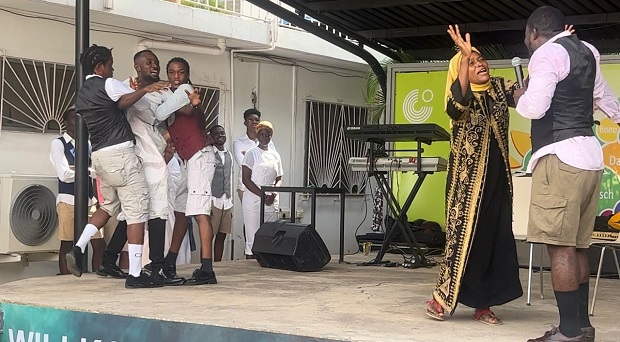
One of the most interesting aspects of the Ghanaian culture is the annual traditional festivals and durbars held in most parts of the country. These festivals are undoubtedly very colourful and they appeal to the very heart of the people.
Celebrated by the people of Ho and Peki of the Volta Region is the Yam Festival. "Ete" is the local word for Yam in the language of the people of the Volta Region. The word literally means "it is swollen". This unique festival is celebrated by the people of Asogli traditional area in the Volta Region.
Yam Cultivation
According to oral history, many years ago a hunter on his normal hunting expedition discovered a tuber of yam in the forest. This occurred during one of the famine periods. Instead of taking his newly discovered tuber home, he decided to hide it in the soil to be used some time later.
After a while, when he came back for the tuber of yam, to his dismay the tuber had germinated and grown bigger. This was how the cultivation of yam started.
Story behind Yam Festival
From "Notsei" in the Republic of Togo, Ewes brought this festival to Ghana several years ago.
The cultivation of yam is not a smooth job, but rather very dull and lazy one. Because it is labour intensive, energy draining and quite dangerous work to do, both in the past and currently, the adage has been coined that "Ne wonye eteti tsogbe wo dua ete la, ne egbor ma kpor etsroa ha du o"... This literally means if it were during the day of planting of yam that yam is eaten, the goat would never taste the peel.
Thus, history has it that in those days, people who ventured into yam cultivation did not live to enjoy the harvest of their labour.
With great determination, permission and guidance from the gods and ancestors of the land are sought during the entire period for good planting through to harvesting.
Normally, harvesting is done in September, the gods and ancestors are served first with the boiled and mashed yam, mostly white and red-oiled, called "bakabake", before any living being (humans or animals) tastes it. This rite is called Dzawuwu". After that, the rest of the mashed yam is eaten as a communal meal, this serves as a symbol of unity and reconciliation of families, clans and the entire communities.
Significance of the Yam Festival
The chiefs of Peki and Ho add some activities to the celebration of the yam festival, which include;
Offering prayers to God and also to the gods and ancestors for a bumper harvest, good health and prosperity for all.
Fostering unity through forgiveness and reconciliation.
Conducting an annual stocktaking event for all occupational endeavours, especially farming.
Mobilizing both human and material resources of Asogli State for job and wealth creation.
Serving as an annual re-affirmation of allegiance by all chiefs and their subjects in the Asogli State to the Agbogbome stool.
The Durbar Day
To round off the festival, a grand durbar is held on the Sunday during which the paramount chief and other divisional clan chiefs from Peki and Ho sit in state to receive homage from their subjects.
The occupants of various stools and families come together at the centre of the town to form a colourful procession to the durbar ground. There is an impressive array of stool properties: a long list of emblem-carrying linguist staffs and state swords, each symbolizing the philosophy and wealth of the stool, state drums; different stools; specially decorated sandals statue of Hosi on the head of a carrier.
There are also other properties, some of which are cosmetics of all kinds, including rich cultural display of different types of beads; simple items such as traditional lamps, blocks of license, and neatly packaged bundles of women's cover clothing and other superficially priceless ornaments.
These items are carefully arranged in brass pans which teenage girls carry on the head to show to the public. The bodies of these girls are decorated with symbolic body decorations. At the durbar ground, libation is poured by both male and female priesthood; rites of sowing and harvesting yams are dramatized usually by cultural troops.
During the period, the people ask the ancestral spirit to prevent and protect them from any future epidemic, famine and to help them ensure bumper harvest in the subsequent years.
It also marks the traditional beginning of a harvesting season. Despite all these, the festival provides a platform for socialization and reunion of the people and families.
Tourist attraction
Tourists from different parts of the world patronise the Yam Festival, which increases the national purse with foreign exchange. The festival is used to educate and entertain both Ghanaians home and abroad and visitors about Asogli traditions. The Yam Festival provides an opportunity for experiencing rich traditional music, dance, storytelling and a grand durbar, which is done to climax the festival.
The Agbogbmefia's role
The Agbogbomefia, who is the traditional overlord of the Asogli State, use his leadership skills and brings unity among many chiefs throughout the Volta Region and has extended this to other parts of Ghana and Togo. As a result, many of these chiefs attend the annual Yam Festival of the people of the Volta Region.
He encourages the importance of different tribes and ethnic groups living on harmony and tolerance, which helps in good governance and national development.
The Yam Festival brings the people closer to their ancestors. There is drumming, dancing and merry-making.
Coming September is another opportunity to join the people of Asogli State to celebrate the unforgettable annual Yam Festival. Thus, add the festival to your September activity plan and let's meet in the Asogli State to celebrate the unforgettable Yam Festival, with the people of Ho and Peki.
Read Full Story
























Facebook
Twitter
Pinterest
Instagram
Google+
YouTube
LinkedIn
RSS